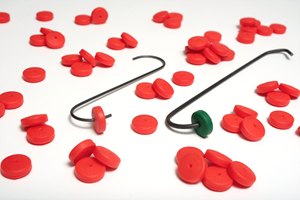Improved In-Process Cleaning
Solvent-based system for complex components
A new solvent-based cleaning system is said to allow rapid and thorough in-line cleaning of geometrically complex workpieces.
Manufacturer Dürr Ecoclean, Inc. GmbH (Filterstadt, Germany) says its EcoCSpeed system offers new advantages for in-line cleaning of individual parts. Using non-halogenated hydrocarbon solvents and multiple process modules that can be loaded in delayed phases via a specially designed handling system, the system allows users to design a flexible cleaning process that may include injection flood washing, steam scouring and vacuum drying. Cycle time can be adjusted to suit the overall manufacturing cycle, and part cleanliness is achieved even for stringent specifications. Process quality and efficiency is ensured by cleaning complex parts individually rather than in batches, according to the company.
In the past, Dürr says, short cycle times and strict cleanliness requirements presented problems for inline cleaning processes—especially those used for cleaning complex, mass-produced workpieces. This type of cleaning required complex, continuous systems; the spraying methods used in many of these systems were only partially able to clean the parts.
The EcoCSpeed system uses non-halogenated solvents to clean complex workpieces such as pumps, cases, anti-lock braking system and fuel injection parts, gears, crankshafts and camshafts. The system can clean workpieces indivuidally or in batch mode using a product carrier.
The basic system is equipped with five process modules designed for part/batch dimensions of up to 370 × 220 × 200 mm (15 × 9 × 8 inches) and weighing up to 30 kg (66 lb). This configuration allows cleaning throughput of 2.7 ton/hr. Overall system dimensions are a relatively modest 7500 × 3500 × 3100 mm (25 × 11.5 × 10 ft).
Dürr says the system’s flexible design makes it possible to equip it with additional process modules to ensure that an overall 40-sec cleaning cycle time is maintained at any level of cleanliness. The cleaning process can be adjusted to meet individual throughput demands and suit specific production cycles.
The process starts when work chambers are loaded in a delayed process by a handling system which is specific to the workpiece or the batch. In the work chambers, the parts are treated by injection flood washing (IFW), steam scouring and vacuum drying. For the IFW, jet systems are arranged in modules through which the cleaning agent is pumped at high pressure into a flooded work chamber. The company says this produces a whirlpool effect which ensures very effective cleaning even in difficult-to-reach areas such as blind holes and undercuts. Vacuum drying is said to leave workpieces completely dry and ready for immediate downstream processing.
Because the entire cleaning process takes place in a vacuum, no special explosion protection measures are necessary to operate the machine, according to Dürr. Additional steps required in immersion cleaning, such as such as grouping of workpieces into product carrier systems and post-cleaning separation, are no longer needed. The result is more effiicient cleaning and improved part quality via elimination of unnecessary handling, the company says.
Features of the sytem include stainless steel piping and continuous pumping and distillation, which is said to reduce the workload on system components compared to sequential usage and extend the overall service life of the machine.
Related Content
Coatings Plant Evolves with Market Trends
Expanding its focus from exclusively serving the RV industry, one of this company’s stand-alone coatings plant has successfully extended its services to additional markets.
Read MoreCFS Unveils New Hook Locks Parts Racking Solution
New product from Custom Fabricating & Supplies (CFS) prevents part loss during coating processes.
Read MoreProfessional Plating Expands Zinc, Ecoat Offerings
Ever expanding, Professional Plating of Brillion, Wisc., has announced two capital investments: a second zinc line and an upgrade of its ecoat capabilities.
Read MoreTTX’s Automated Conveyor Carrier System Offers Wireless, Flexible Operation
ACC system designed for reliable, consistent point-to-point movement of everything from small to heavy parts.
Read MoreRead Next
Education Bringing Cleaning to Machining
Debuting new speakers and cleaning technology content during this half-day workshop co-located with IMTS 2024.
Read MoreDelivering Increased Benefits to Greenhouse Films
Baystar's Borstar technology is helping customers deliver better, more reliable production methods to greenhouse agriculture.
Read MoreA ‘Clean’ Agenda Offers Unique Presentations in Chicago
The 2024 Parts Cleaning Conference, co-located with the International Manufacturing Technology Show, includes presentations by several speakers who are new to the conference and topics that have not been covered in past editions of this event.
Read More













.jpg;maxWidth=300;quality=90)







